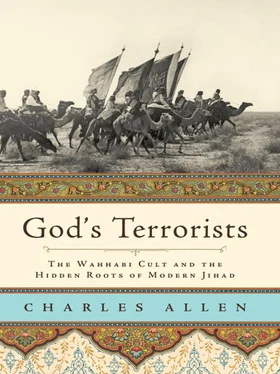Charles Allen - God's Terrorists
Здесь есть возможность читать онлайн «Charles Allen - God's Terrorists» весь текст электронной книги совершенно бесплатно (целиком полную версию без сокращений). В некоторых случаях можно слушать аудио, скачать через торрент в формате fb2 и присутствует краткое содержание. Город: Boston, Год выпуска: 2011, ISBN: 2011, Издательство: Da Capo Press, Жанр: История, religion_islam, на английском языке. Описание произведения, (предисловие) а так же отзывы посетителей доступны на портале библиотеки ЛибКат.
- Название:God's Terrorists
- Автор:
- Издательство:Da Capo Press
- Жанр:
- Год:2011
- Город:Boston
- ISBN:978-0-306-81522-5
- Рейтинг книги:5 / 5. Голосов: 1
-
Избранное:Добавить в избранное
- Отзывы:
-
Ваша оценка:
- 100
- 1
- 2
- 3
- 4
- 5
God's Terrorists: краткое содержание, описание и аннотация
Предлагаем к чтению аннотацию, описание, краткое содержание или предисловие (зависит от того, что написал сам автор книги «God's Terrorists»). Если вы не нашли необходимую информацию о книге — напишите в комментариях, мы постараемся отыскать её.
God’s Terrorists
God's Terrorists — читать онлайн бесплатно полную книгу (весь текст) целиком
Ниже представлен текст книги, разбитый по страницам. Система сохранения места последней прочитанной страницы, позволяет с удобством читать онлайн бесплатно книгу «God's Terrorists», без необходимости каждый раз заново искать на чём Вы остановились. Поставьте закладку, и сможете в любой момент перейти на страницу, на которой закончили чтение.
Интервал:
Закладка:
Mackeson could have put an end to the Hindustani Fanatics at Sittana in January 1853. But the Commissioner had just received the Governor-General’s Minute, telling him to leave things as they were. So he did not order a pursuit, later justifying his inaction on the grounds that he had done all that was required of him: ‘He considered their flight, without offering resistance, would generally increase the contempt in which they were held by the surrounding tribes, and would be more useful to us than any persecution of them could be.’
Mackeson’s failure to follow up his raid probably cost him his life. Had he done so, the history of the North-West Frontier might well have been very different. But Frederick Mackeson, like Lord Dalhousie before him and many others who came after, underestimated the Hindustani Fanatics. Intelligence existed to show the movement’s true nature, but this information was disregarded. It was not the first time the Hindustani Fanatics were let off the hook, and it was certainly not the last.
What the British came to know as the Fanatic Camp at Sittana had been established almost a quarter of a century earlier on the eastern slopes of Mahabun Mountain overlooking the Indus Valley. It was on land granted in perpetuity as a religious gift by the local Yusufzai back in the sixteenth century to a renowned saint named Pir Baba, who was a Saiyyed descended from the Prophet. After the Sikhs annexed neighbouring Hazara and the Vale of Peshawar, Sittana became a refuge and a rallying point for resisters – or, as a British intelligence officer put it, ‘the refuge for outlaws and offenders from Yusufzai and Hazara, and the rendezvous of all the discontented Khans and their followers’. Then in the winter months of 1827–8 a very different kind of resister appeared on the Frontier: SYED AHMAD of Rae Bareli, founder and first of the Hindustani Fanatics.
Syed Ahmad was born Syed Ghullam Muhammad in 1786 in the town of Rae Bareli, on the Gangetic plains between Lucknow and Allahabad in the kingdom of Oude. As his first name implies, his family claimed descent from the Prophet, which marked him out as someone to be respected by virtue of his inherent sanctity and to be accorded the honorific title of shah (king). According to his several biographers, he grew up into a model of perfection: tall, strong and fair, with close-knit eyebrows and a long and bushy beard. He was said to have had a great appetite for physical sports, including wrestling, swimming, archery and shooting. This gave him an imposing physique that set him apart from most clerics, yet he was apparently taciturn and gentle in demeanour, with a quiet voice that could be heard by all who wished to hear him. As one biography put it, ‘All the perfections… were implanted from his birth in this holy man, as evidenced from the delight which he took in the exercise of piety and practice of virtue from his childhood.’ Like the Prophet, he fell from time to time into deep ecstatic trances, indicating that he was in direct communication with God.
After his father’s death in 1800 the fourteen-year-old moved to Delhi to become a talib of the leading scholar of the age, SHAH ABDUL AZIZ, principal of a small but greatly respected religious school known as Madrassah-i-Rahimiya, tucked away in the back streets of the old city. According to the author of Sirat-ul-Mustaqim , the best known of the biographies, ‘When he was admitted into the society of the venerated Sheikh Abdul Aziz, who received him as a disciple of the Nakshbandia school, by the propitious effects and influence of the enlightened spirit of his instructor, the concealed excellencies of his nature developed themselves in a natural succession of wonders.’ Among these wonders were three dreams: in the first the Prophet fed the boy with three dates; in the second the Prophet’s daughter Fatima bathed him, washed him and dressed him in garments ‘of exceeding richness’; in the third God placed him on his right hand, showed him his treasures and said to him ‘This I have given to you, and I shall give you yet more.’ Clearly Syed Ahmad was destined for great things – although it should always be borne in mind that the hagiographers who wrote about him did so as leading practitioners of the cult of Syed Ahmad that developed after his untimely demise.
Syed Ahmad was extremely fortunate in having Shah Abdul Aziz for his teacher, for he was the eldest son and religious successor of the renowned Sufi scholar and reformer SHAH WALIULLAH of Delhi, who has been described by a leading modern historian as ‘the bridge between medieval and modern Islam in India’. Half a century earlier Shah Waliullah had set out to make Islam more accessible by translating the Quran , the word of God divinely revealed to his Prophet Muhammad, from Arabic into Persian. He had also called for moral reform and a return to the pristine Islam of the days of the Prophet as set down in the Quran and the Hadith , a corpus of accounts of the deeds and sayings of the Prophet as remembered by his companions. As part of this process of reform Shah Waliullah had broken with religious convention by setting himself up as a mujtahid , one who makes his own interpretations of established religious law by virtue of informed reasoning.
In the public mind, however, Shah Waliullah had been best known for his unavailing efforts to restore Muslim rule to Hindustan, culminating in a famous appeal to the Afghan ruler Ahmad Shah Abdali to invade India, destroy the Hindu Marathas in battle and bring back the golden years of the Mughal Emperor Aurangzeb. In the event, Ahmad Shah had been forced to retreat to Afghanistan and the Marathas had once again become the dominant power in northern India. But the dream of an Islamic revival and of Hindustan under sharia had been kept alive by Shah Waliullah’s four sons, with the Madrassah-i-Rahimiya acknowledged as the most influential seminary in all Hindustan.
Islam east of the Indus River had developed along different lines from that followed in the faith’s heartlands. It had reached almost every corner of the sub-continent, but was a minority religion everywhere other than in East Bengal (now Bangladesh) and in perhaps half a dozen regional centres such as Delhi, Lucknow and Hyderabad. Contrary to what some Hindu nationalist historians would have us believe, most conversions to Islam had been voluntary, inspired as much by the challenge to the Hindu caste system represented by Islamic egalitarianism as by the examples of Sufi saints, who in many areas preceded the Muslim invasions. Islam represented a rare opportunity for social betterment, so it followed that most of these converts came from the bottom of the pile, as exemplified by the weavers and artisans of East Bengal. Most of them became willing if ignorant followers of the Hanafi school of law, the oldest, most inclusive and least hierarchical of the four schools of jurisprudence of the Sunnis, the Islamic mainstream which followed the precedents established by the Prophet and his immediate successors and acknowledged the authority of the line of caliphs who came after them.
The many waves of Turko-Afghan invaders who settled in northern India were also Sunnis, again mostly Hanafis, whereas the Persians who came with the Mughals were predominantly Shia, the largest minority sect in Islam, which regarded Imam Ali and his line as the legitimate descendants of the Prophet and thus the only true source of religious authority – a view considered heretical by orthodox Sunnis. However, centuries of contact with Hinduism also led to a measure of synthesis between it and both Sunni and Shia interpretations of Islam – an intermingling of views and practices that reformers such as Shah Waliullah and his sons found highly objectionable.
Elements of racism also came into play. Even though Islam stood for the equality of all men before God, the Muslim community in India developed a hierarchy that in many respects mirrored the Hindu caste system, a pecking order in which Hindustani Muslims descended from Hindu converts were at the bottom and those of Arab descent at the top, closely followed by Mughal, Persian and Afghan settlers. At the very pinnacle, naturally enough, were the Saiyyeds, whose descent from the Prophet accorded them respect bordering on veneration, enabling them to exercise what was generally a moderating influence on society by acting as mediators in disputes and as religious patrons. A significant number among this Muslim aristocracy resented their loss of power and equated it with the watering-down of Islam’s core values since the days of Emperor Aurangzeb. Many also embraced Sufi mysticism. The reformer Shah Waliullah was himself a follower of the Naqshbandi Sufi school, based on a movement originating in Bokhara in the fourteenth century which eschewed music and dance in favour of silent contemplation, and sought to recapture the simple intensity of early Islam through personal devotion. However, there are Sufis and Sufis. Prior to Shah Waliullah, the best-known Naqshbandi Sufi in India was Sheikh AHMAD SIRHINDI, who had been so appalled by the religious tolerance promoted by Emperor Akbar that when Jehangir succeeded him he began a political campaign to restore what he regarded as true Muslim values. These were centred on the overarching importance of tawhid , the oneness of God or absolute monotheism, as the basis of true religion, and on the need to combat all innovations and deviations from tawhid, as represented not only by Shia beliefs but also by many of the popular customs that had been adopted by Sunnis over the centuries. Ahmad Sirhindi’s application of Naqshbandi Sufism expressed itself in violent intolerance of Sunni backsliders and in the persecution of Shias and Hindus. Despite being proscribed in later years, the Sirhindi movement continued to inspire Sunni fundamentalists – among them Shah Waliullah, his four sons and those who studied under them at Delhi’s Madrassah-i-Rahimiya.
Читать дальшеИнтервал:
Закладка:
Похожие книги на «God's Terrorists»
Представляем Вашему вниманию похожие книги на «God's Terrorists» списком для выбора. Мы отобрали схожую по названию и смыслу литературу в надежде предоставить читателям больше вариантов отыскать новые, интересные, ещё непрочитанные произведения.
Обсуждение, отзывы о книге «God's Terrorists» и просто собственные мнения читателей. Оставьте ваши комментарии, напишите, что Вы думаете о произведении, его смысле или главных героях. Укажите что конкретно понравилось, а что нет, и почему Вы так считаете.












